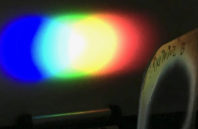Engineering and physics researchers at North Carolina State University have developed a new technology for steering light that allows for more light input and greater efficiency – a development that holds promise for creating more immersive augmented-reality display systems. At issue are diffraction gratings, which are used to manipulate light in everything from electronic displays to fiber-optic communication technologies.
“Until now, state-of-the-art diffraction gratings configured to steer visible light to large angles have had an angular acceptance range, or bandwidth, of about 20 degrees, meaning that the light source has to be directed into the grating within an arc of 20 degrees,” says Michael Escuti, a professor of electrical and computer engineering at NC State and corresponding author of a paper on the work. “We’ve developed a new grating that expands that window to 40 degrees, allowing light to enter the grating from a wider range of input angles. The practical effect of this – in augmented-reality displays, for example – would be that users would have a greater field of view; the experience would be more immersive.”

 (585) 768-2513
(585) 768-2513

